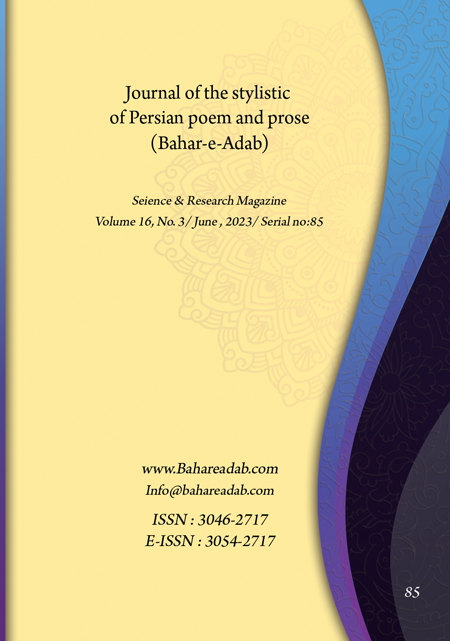- Count View : 361
- آدرس کوتاه شده مقاله: https://bahareadab.com/article_id/1468
- کد doi مقاله: Doi: 10.22034/bahareadab.2023 .16 .6828
Journal of the stylistic of Persian poem and prose
volume Number 16،
number In Volume 3،
،
issue Number 85
The pattern of dialogue and intertextuality In the text of Attar’s Mantiq al-Tair
Yusuf Esfandiar (Author in Charge), Seyyed Esmaeil Ghafelehbashi
Abstract
BACKGROUND AND OBJECTIVES: To what extent a text is related to previous, contemporary and later texts and is influenced by those texts in the linguistic, semantic, etc. fields, depending on the importance and value of that text, it is often investigated by commentators and scholars. Critics are placed. What is more important and emphasized in the criticism of modern texts is the type of communication and dialogue that is established in the shadow of intertextuality and intersubjectivity to create dialogue networks with previous, contemporary and future texts. The term intertextuality and intersubjectivity, etc., should be searched for in the thoughts of Bakhtin and his fans. However, examining the types of dialogue and its applications between the author, the narrator, the text and the audience is important to determine the grading of the texts; A text like Mantiq al-Tair as a valuable Persian mystical system can be the middle link of many of these conversations. In this research, the writer aims to observe the types of methods of the author/narrator in the creation of a conversational network and intertextual communication in the target text.
METHODOLOGY: Since this research is based on the text of Mantiq al-Tair, the authors will try to examine the concepts of the theories presented in the text, using the library and sampling method.
FINDINGS: The text of Mantiq al-Tair throughout is a scene of intertextual dialogue and connection with past texts and holy books.
CONCLUSION: Attar creates a network of dialogue between generations and between different strata of society by using human characteristics, symbols and using communication tools. The existence of common narratives between Mantiq al-Tair and earlier and later works, including the Masnavi of Rumi and later texts, confirms the existence of dialogue relationships in the text.
Keyword
Dialogue
, Bakhtin
, Intertextuality
, Open Source
, Closed Text
, Attar’s Mantiq al-Tair
- Ashrafzadeh, R. (2007). water burning fire (A collection of articles about Mantiq al-Tair). Mashhad: Astane qodse razavi.
- Attar, F. (1989). Mantiq al-Tair. Edited by Goharin. S. Tehran: Elmi and farhangi.
- Bahremand, Z. (2010). “Irony and its difference with humor and similar rhetorical arts”. Persian language and literature, 45, pp. 36-39.
- Bakhtine, M. (2008). Conversational analysis of essays about the novel. Translated by poorazar, Roya. Tehran: Nashre Ney.
- Forooqi, M. (1965). Rite of speech. Tehran: Zavvar.
- Fotohi, M. (2006). Image rhetoric. Tehran: Sokhan.
- Hafez, Sh. (1998). Divan of Hafez's Ghazals. Edited by Khatib rahbar, Kh, Tehran: Safi alishah.
- Heydari, M. (2008). “The role of narrator and narration in Sufi stories”. Journal of Faculty of Literature and Human Sciences, (62), pp.59-91.
- Khaqani, A. (1972). Excerpts of poems. By the efforts of Seyyed Ziauddin Sajjadi. Tehran: Jibi.
- Marzban, P and Maroof, H. (2012). “Illustrated culture of visual arts”. Bahar Adab magazine. (18), pp.327-342.
- Minovi, M. (1961). Khaxayen Torkiye, Journal of Faculty of Literature (University of Tehran), (3), pp.11-12.
- Molana. (1985). Masnavi Ma’navi. Edited by Nikelson, R. Tehran: Elmi.
- Namvar motlaq, B. (2008). “Bakhtin, dialogism and polyphony, the study of Bakhtin's seminal security”. Journal of Human Sciences. (57), pp.397-414.
- Namvar motlaq, B. (2011). An introduction to intertextuality. (Theories and applications). Tehran: Sokhan.
- Nasre khosrow. (2008). Description of thirty odes. Edited by Mohaqqeq.M. Tehran: Toos.
- Payandeh, H. (2009). Literary criticism and democracy (Essays in new literary theory and criticism). Tehran: Niloofar.
- Rohani, R. (2005). “Rumi about the relationship between the text and the author of the audience and other texts”. Journal of Literary Studies and Research. (5 and6), pp.33-54.
- Salimi kochi, E. (2014). “Intertextual relationships and attention to dialogue in Qaiser Aminpour's poetic language”. journal of language essays, (19) pp. 81-100.
- Sana’i Qaznavy, A. (1981). Masnavis of Hakim Sana'i. Edited by Seyyed MohammadTaghi Modarres Razavi. Tehran: babak.
- Sattari, J. (2002). A research on the story of Sheikh Sanan. Tehran: Markaz.
- Seyedabadi, A. (2006). Passing traditional audience. Tehran: Farhangha.
- Sho’eyri, H. (2010). Analysis of the semantics of the discourse. Tehran: Samt.
- Tavakkoli, H. (2010). Narration boutiques in Maulana's Masnavi (From the signs of the sea). Tehran: Morvarid.
- Yeylaqi, M. (2007). Lesan al qeyb is Reader response theory. Dissertation of Allameh Tabatabayi University.

